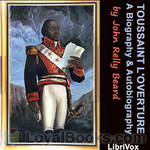|
Books Should Be Free Loyal Books Free Public Domain Audiobooks & eBook Downloads |
|
|
Books Should Be Free Loyal Books Free Public Domain Audiobooks & eBook Downloads |
|
Books of Memoirs |
|---|
|
Book type:
Sort by:
View by:
|
By: Edna Brush Perkins (1880-1930) | |
|---|---|
 The White Heart of Mojave
The White Heart of Mojave
"The White Heart of the Mojave" recounts a 1920's adventure "in the wind and sun and big spaces" of Death Valley by two independent minded women, Edna Brush Perkins and Charlotte Hannahs Jordan. Both women were early feminists, Edna as chairwoman of the greater Cleveland Woman's Suffrage Party (1916-18). At the end of the Great War, the two friends wanted nothing more than to escape "to the solitariness of some wild and lonely place far from city halls, smokestacks, national organizations, and streets of little houses all alike... | |
By: John Relly Beard (1800-1876) | |
|---|---|
 Toussaint L’Ouverture: A Biography and Autobiography
Toussaint L’Ouverture: A Biography and Autobiography
François-Dominique Toussaint L’Ouverture (1743-1803) rose to fame in 1791 during the Haitian struggle for independence. In this revolt, he led thousands of slaves on the island of Hispañola to fight against the colonial European powers of France, Spain and England. The former slaves ultimately established the independent state of Haiti and expelled the Europeans. L’Ouverture eventually became the governor and Commander-In-Chief of Haiti before recognizing and submitting to French rule in 1801... | |
By: Dreiser, Theodore (1871-1945) | |
|---|---|
 Hollywood: Its Morals and Manners
Hollywood: Its Morals and Manners
Serialized in Shadowland from November 1921 to February 1922, Hollywood: Its Morals and Manners is Theodore Dreiser's shocking four part expose on the motion picture industry. In it, he shares his observations from his extended stay in Los Angeles, and gives us an intimate look at the seedier underside of Hollywood. | |
By: Anonymous | |
|---|---|
 Young Girl's Diary
Young Girl's Diary
The diary of an upper middle class Austrian girl, this book describes her life between the ages of eleven and fourteen. It's a coming of age story full of angst, boys, and questions. | |
By: Various | |
|---|---|
 National Geographic Magazine Vol. 01 No. 2
National Geographic Magazine Vol. 01 No. 2
National Geographic Magazine Volume 1 Number 2 published in 1889. Topics of articles are:Africa, its Past and Future Reports on:Geography of the LandGeography of the SeaGeography of the AirGeography of Life | |
By: William Alexander MacKay (1842-1905) | |
|---|---|
 Zorra Boys at Home and Abroad, or, How to Succeed
Zorra Boys at Home and Abroad, or, How to Succeed
By Zorra, in the following sketches, is meant a little district in Oxford county, Ontario, some ten miles square, composed of part of East and part of West Zorra, and containing a population of about fourteen hundred. It was settled about the year 1830, chiefly by Highlanders from Sutherlandshire, Scotland.Within the last forty years there have gone from this district over one hundred young men who have made their mark in the world. With most of these it has been the writer's good fortune to be personally and intimately acquainted; and companionship with some of them has been to him a pleasure and a benefit... | |
By: Agnes Repplier (1855-1950) | |
|---|---|
 In Our Convent Days
In Our Convent Days
With her usual wit and charm, Ms. Repplier recalls her days at Eden Hall, the Convent of the Sacred Heart in Torresdale, north of Philadelphia. She shares the highlights (and some of the low lights) of her time there. Perhaps this sharp eye, nurtured by her willfulness and independent spirit, was the reason she was not invited to return to Eden after her second year. Not only Catholics or boarding school alumnae will find this book entertaining; anyone who went to school or who looks back on their childhood will see their own experience somewhere in this memoir. | |
By: Reuben Gold Thwaites (1853-1913) | |
|---|---|
 Historic Waterways
Historic Waterways
Historic Waterways, Six Hundred Miles of Canoeing down the Rock, Fox and Wisconsin Rivers.This volume is the record of six hundred miles of canoeing experiences on historic waterways in Wisconsin and Illinois during the summer of 1887. There has been no attempt at exaggeration, to color its homely incidents, or to picture charms where none exist. It is intended to be a simple, truthful narrative of what was seen and done upon a series of novel outings through the heart of the Northwest. If it may induce others to undertake similar excursions, and thus increase the little navy of healthy and self-satisfied canoeists, the object of the publication will have been attained. | |
By: John D. Rockefeller (1839-1937) | |
|---|---|
 Random Reminiscences of Men and Events
Random Reminiscences of Men and Events
A good book by the oil revolutionist of the 20th century. As they say "Men should listen to experience" and this book is all about the experience of the second highest taxpayer of the US during the 20's. Though it is not in the book, this is a small poem he wrote:I was early taught to work as well as play,My life has been one long, happy holiday;Full of work and full of play-I dropped the worry on the way- And God was good to me everyday. | |
By: Mary Roberts Rinehart (1876-1958) | |
|---|---|
 Through Glacier Park
Through Glacier Park
This is about a three-hundred mile trip across the Rocky Mountains on horseback with Howard Eaton. It is about fishing, and cool nights around a camp-fire, and long days on the trail. It is about a party of all sorts, from everywhere, of men and women, old and young, experienced folk and novices, who had yielded to a desire to belong to the sportsmen of the road. And it is by way of being advice also. Your true convert must always preach. (Introduction by Mary Roberts Rinehart quoted from the text.) | |
By: Ki no Tsurayuki (872-945) | |
|---|---|
 The Tosa Diary
The Tosa Diary
Ki no Tsurayuki was a Japanese waka poet of the Heian period. In 905, he was one of the poets ordered to compile the "Kokinshu - Collected Japanese Poems of Ancient and Modern Times". He is also one of the Thirty-six Poetry Immortals of Japan. The Tosa Diary, written in 935, is considered the major work of Tsurayuki. It is an account of his return to the capital Kyoto from Tosa province, where he had served as governor since 930. The journey is by boat, and Tsurayuki tells about his sea sickness and fear of pirates, his impressions of the coast, and the various offerings to placate the gods of the sea... | |
By: Pearl White (1889-1938) | |
|---|---|
 Just Me
Just Me
Perhaps the first memoir written by a film celebrity, Pearl White's Just Me gives a first-person account of the actress' rise to stardom. White guides us through her early childhood, her development as a performer, and finally to her breakout role in The Perils of Pauline--a role that made her the most popular "serial queen" of early cinema. Although romanticized and somewhat embellished, this book gives us a fascinating glimpse into the film industry's earliest years and the various myths of film stardom. | |
By: Francis Archibald Bruton (1860-1929) | |
|---|---|
 Three Accounts of Peterloo
Three Accounts of Peterloo
A companion volume to F.A. Bruton's 'The Story of Peterloo', the full title of this short collection is 'Three Accounts of Peterloo by Eyewitnesses, Bishop Stanley, Lord Hylton, John Benjamin Smith with Bishop Stanley's Evidence at the Trial'. The three contemporary accounts, each with a short introduction by the editor, give different perspectives on the events of 16 August 1819, when a troop of Hussars accompanied by the local Yeomanry rode into a peaceful reform rally at St. Peter's Fields, Manchester, leaving 18 dead and more than 700 injured. | |
By: Phoebe Yates Pember (1823-1913) | |
|---|---|
 Reminiscences of a Southern Hospital, by Its Matron
Reminiscences of a Southern Hospital, by Its Matron
Phoebe Yates Pember served as a matron in the Confederate Chimborazo military hospital in Richmond, Virginia, during the Civil War, overseeing a dietary kitchen serving meals to 300 or more wounded soldiers daily. Reminiscences of a Southern Hospital is her vivid recounting of hospital life and of her tribulations (and personal growth) as a female administrator. To follow her from day one, when she is greeted with “ill-repressed disgust” that “one of them had come,” and she, herself, “could... | |
By: Hiram Bingham (1875-1956) | |
|---|---|
 Explorer in the Air Service
Explorer in the Air Service
Explorer Hiram Bingham discovered Machu Picchu in 1911, as recounted in his book Inca Lands, now released on Librivox at http://librivox.org/inca-lands-by-hiram-bingham/. In 1917, he became an aviator and organized the United States Schools of Military Aeronautics at eight universities to provide ground school training for aviation cadets, and then in Issoudun, France, Bingham commanded the primary Air Service flying school. He became a supporter of the Air Service in their post-war quest for independence from the Army and supported that effort, in part, with the publication of this book of his wartime experiences published in 1920 by Yale University Press. | |
By: Charles Ball (1780-?) | |
|---|---|
 Fifty Years in Chains; or The Life of an American Slave
Fifty Years in Chains; or The Life of an American Slave
This is the story of Charles Ball, an American slave who was born in 1780 and remained a slave for fifty years thereafter. Ball told his story to a lawyer who turned it into this written work. | |
By: Ivan Goncharov (1812-1891) | |
|---|---|
 Oblomov
Oblomov
Oblomov is the best known novel by Russian writer Ivan Goncharov, first published in 1859. Oblomov is also the central character of the novel, often seen as the ultimate incarnation of the superfluous man, a symbolic character in 19th-century Russian literature. Oblomov is a young, generous nobleman who seems incapable of making important decisions or undertaking any significant actions. Spoiled as a child to the point of not even being able to put on his own socks, Oblomov is unprepared to deal with the smallest difficulty of adult life... | |
By: Jane Barlow (1857-1917) | |
|---|---|
 Irish Idylls
Irish Idylls
Irish Idylls is a collection of short stories about Irish peasantry during the 19th Century. Ms Jane Barlow, an Irish lass, having, unbelievably, an uncertain date of birth, has a turn of phrase that delights and simultaneously enmeshes the reader/listener with compassion for her tableau. She captures the tune and lilt of dialogue so delightfully. A tiny sample: "So, by hook or by crook, Lisconnel holds together from year to year, with no particular prospect of changes; though it would be safe enough to prophesy that should any occur, they will tend towards the falling in of derelict roofs, and the growth of weeds round deserted hearthstones and crumbling walls... | |
By: Joseph Benjamin Polley (1840-1918) | |
|---|---|
 Soldier's Letters to Charming Nellie
Soldier's Letters to Charming Nellie
Whether written in camp, in hospital, or in hospitable home, the letters tell a plain, unvarnished, and true story of the observations and experiences, the impressions and feelings, of a soldier whose only personal regret is that he could not be one of those whose paroles at Appomattox are patents incontestable that they fought for the right as they saw it, as long as there was a hope to encourage them. Though not intended as history, they are historical in the respect that they narrate actual occurrences in camp, on the march, and in the battle... | |
By: Solomon Northup (1808 - c. 1864-18) | |
|---|---|
 Twelve Years a Slave
Twelve Years a Slave
Twelve Years a Slave is the memoir of a freeborn African American from New York who is kidnapped and sold into slavery. After being held for twelve years on a Louisiana plantation, he is eventually freed and reunited with his family. | |
By: George William Foote (1850-1915) | |
|---|---|
 Prisoner for Blasphemy
Prisoner for Blasphemy
George William Foote, a British secularist, was convicted and imprisoned on the charge of blasphemy after founding "The Freethinker", a magazine that, despite the best efforts of the 19th Century British judicial system, is still going strong. "Prisoner for Blasphemy" is a memoir of his several trials and final imprisonment in Holloway Gaol. Although Foote's was the last prominent blasphemy case in England, his hope that the blasphemy law would soon be abolished was not to be realised until almost a century after his death, in 2008. | |
By: William Bligh (1754-1817) | |
|---|---|
 Mutiny of the Bounty and Other Narratives
Mutiny of the Bounty and Other Narratives
In Bligh's own words, we hear about the lead-up to the famous mutiny and what happened afterwards with the mutineers and the castaways. This work contains two additional narratives by Bligh: Life of a Sailor Boy and The Sunken Treasure. | |
By: Pat O'Brien (1890-1920) | |
|---|---|
 Outwitting The Hun; My Escape From A German Prison Camp
Outwitting The Hun; My Escape From A German Prison Camp
A true war narrative, published in 1918 while WWI was still going on. | |
By: Elizabeth Bacon Custer (1842-1933) | |
|---|---|
 Boots and Saddles
Boots and Saddles
Elizabeth Custer has penned an engaging portrait of 1870’s life on a U.S. cavalry post in the Dakotas, just before her husband and his troops met their tragic deaths in the Battle of the Little Big Horn. “Our life,” she writes, “was often as separate from the rest of the world as if we had been living on an island in the ocean.” Her portrait of her husband, General George Armstrong Custer is laudatory—his intellect, his love of dogs (he kept a hunting pack of 40 at the post); but, Boots and Saddles is more than just a memorial... | |
By: Charles Anderson Dana (1819-1897) | |
|---|---|
 Recollections of the Civil War
Recollections of the Civil War
Recollections of the Civil War records the events that took place during the American Civil war. It forms one of the most remarkable volumes of historical, political, and personal reminiscences which have been given to the public. Mr. Dana wrote these Recollections of the civil war according to a purpose which he had entertained for several years. They were completed only a few months before his death on October 17, 1897. Go to the e-book on this book's catalog page for some great illustrations and an index. | |
By: George Borrow (1803-1881) | |
|---|---|
 Wild Wales
Wild Wales
Wild Wales: Its People, Language and Scenery is a travel book by the English Victorian gentleman writer George Borrow (1803–1881), first published in 1862 and now a classic travel text on Wales and the Welsh. The book recounts Borrow's experiences, insights and personal encounters whilst touring Wales alone on foot after a family holiday in Llangollen in 1854. Although contemporary critics dismissed its whimsical tone, it quickly became popular with readers as a travel book and more importantly as a very lively account of the literary, social and geographical history of Wales... | |
By: Thomas Dallam (c 1570-) | |
|---|---|
 Dallam's Travels with an Organ to the Grand Signieur, 1599-1600
Dallam's Travels with an Organ to the Grand Signieur, 1599-1600
Queen Elizabeth the First of England, the Grand Turk at Constantinople, and an organ builder named Thomas Dallam—quite a trio. In 1599, Elizabeth commanded master organ builder Dallam to construct and deliver to the Grand Signieur , as a present intended to garner trade and political advantages for England, a fantastic mechanical organ. Dallam’s wonder stood 16 feet high and was topped by a silver holly bush filled with blackbirds and thrushes that sung and shook their wings. Dallam kept a diary during his visit to Turkey, which included a sneak look through a grate at the Grand Turk’s concubines in the harem... | |
By: Edward Carpenter (1844-1929) | |
|---|---|
 My Days and Dreams
My Days and Dreams
Hard to imagine now, but there have been times and places where just wearing sandals could get you labeled as being in rebellion against established society. Two such places were Berkeley, California in the early 1960s and Millthorpe, England in the 1880s. Millthorpe was home to Edward Carpenter (1844-1929), an English socialist poet, philosopher, and activist who abandoned his upper crust life and university sinecure to grow market vegetables and handcraft sandals for a living. Carpenter’s search for the well-lived life, his passions and concerns resonate uncannily with the mood of long ago Berkeley... | |
By: Donald Shaw | |
|---|---|
 Eighteen Months' Imprisonment
Eighteen Months' Imprisonment
This is an absorbing memoir of an inmate's experiences and impressions while in a London prison. He describes himself as "a man of education and worldly experience" and weighing "19 stone 13 lbs" (279 lbs), a stone being 14 lbs, at the beginning of his imprisonment but not upon his release. The author writes with a reporter's keen perception and a talented novelist's ability to engage and at times amuse the reader. | |
By: George Savile Marquis of Halifax (1633-1695) | |
|---|---|
 Complete Works of George Savile, first Marquess of Halifax, with an Introduction by Walter Alexander Raleigh
Complete Works of George Savile, first Marquess of Halifax, with an Introduction by Walter Alexander Raleigh
George Savile, 1st Marquess of Halifax (11 November 1633 – 5 April 1695) was an English statesman, writer, and politician who sat in the House of Commons in 1660, and in the House of Lords after he was raised to the peerage in 1668. He's noted in history for his views on Charles II among others. This compilation covers a wide range of his views which are particularly telling, coming, as they do, from a man who was singularly positioned among the powers of the time, to make them. Prepare yourself for a journey into antiquated English speech. | |
By: Sarah Emma Edmonds (1841-1898) | |
|---|---|
 Nurse and Spy in the Union Army
Nurse and Spy in the Union Army
The “Nurse and Spy” is simply a record of events which have transpired in the experience and under the observation of one who has been on the field and participated in numerous battles—among which are the first and second Bull Run, Williamsburg, Fair Oaks, the Seven days in front of Richmond, Antietam, and Fredericksburg—serving in the capacity of “Spy” and as “Field Nurse” for over two years.While in the “Secret Service” as a “Spy,” which is one of the most hazardous positions in the army—she penetrated the enemy’s lines, in various disguises, no less than eleven times; always with complete success and without detection... | |
By: James Berry (1852-1913) | |
|---|---|
 My Experiences as an Executioner
My Experiences as an Executioner
From 1884 until 1891, James Berry was an executioner. In this time he carried out 131 hangings. In this memoir he writes about the methods he used, and the final moments of some of those he executed. | |